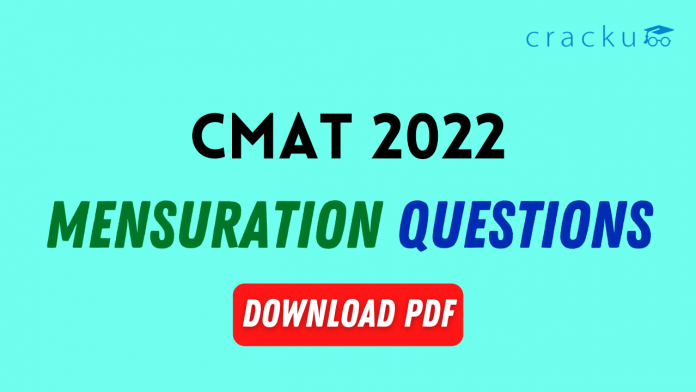Mensuration Questions for CMAT 2022 – Download PDF
Download CMAT 2022 Mensuration Questions pdf by Cracku. Very Important Mensuration Questions for CMAT 2022 based on asked questions in previous exam papers. These questions will help your CMAT preparation. So kindly download the PDF for reference and do more practice.
Download Mensuration Questions for CMAT
Get 5 CMAT mocks at just Rs.299
Download CMAT previous papers PDF
Question 1: The length of a rectangle is increased by 25% and the breadth of the rectangle is decreased by 25%. What is the percentage change in the area of the rectangle?
a) 5% decrease
b) 5% increase
c) 6.25% increase
d) 6.25% decrease
e) None of the above
Question 2: If the length of a rectangular field is increased by 20% and the breadth is reduced by 20%, the area of the rectangle will be 192 $m^2$. What is the area of the original rectangle?
a) 184 $m^2$
b) 196 $m^2$
c) 200 $m^2$
d) 225 $m^2$
e) None of these
Question 3: What is the area of a rectangle with length equal to 2 times the breadth which is equal to the side of square whose area is 361 sq.m.
a) 728
b) 762
c) 721
d) 722
e) 781
Question 4: If length of a rectangle with breadth 5 m is equal to the area of a square with side 4m
What will be the area of rectangle?
a) 19
b) 20
c) 70
d) 80
e) 90
Question 5: If the side of a square is increased by 20%, what will be the increment in its area?
a) 40
b) 44
c) 48
d) 50
e) 55
Download CMAT Previous Papers PDF
Question 6: The diameter of a wheel is 343 m. How many revolutions will it make to cover a distance of 10780 m.
a) 10
b) 11
c) 12
d) 13
e) 14
Question 7: Length and Breadth of a rectangle are 14m. and 16m. and its area is equal to the length of a square. What will be the length of the diagonal of the square?
a) 222
b) 223
c) 224
d) $224\sqrt2$
e) 225
Question 8: If length of a rectangle is increased by 10% and breadth of a rectangle is increased by 20%, then what will be the increment in area of rectangle?
a) 33.33%
b) 55%
c) 32%
d) 64%
e) 66.66%
Question 9: If the radius of a circle is equal to the side of a square, what is the ratio of the perimeters of the circle to the square?
a) $\pi$:1
b) $\pi$:2
c) $\pi$:3
d) 2:$\pi$
e) None of the above
Question 10: Find the value of the radius of the circle if its circumference is equal to the rectangle whose length is 14cm and breadth 8cm?
a) 7cm
b) 14cm
c) 16cm
d) 8cm
e) 6 cm
Question 11: A square has the side equal to the diameter of a circle. If the perimeter of the square is 20 metres, what is the perimeter of the circle?
a) 14.7
b) 15.7
c) 16.7
d) 17.7
e) None of the above
Question 12: There is a square of a certain area. The side of the square is now increased in such a way that the area of the square increases by 69%. What is the percentage increase in the side of the square?
a) 30%
b) 32%
c) 28%
d) 25%
e) 40%
Question 13: The length of a rectangle is greater than the side of a square by 4 cm and the the breadth of the rectangle is less than the side of the square by 6 cm. Given that the area of the square is 441 sq cm, find the area of the rectangle.
a) 225 sq cm
b) 361 sq cm
c) 289 sq cm
d) 375 sq cm
e) None of these
Question 14: The length of a rectangle is increased by 2 cm and the breadth of the rectangle is also increased by 2 cm. As a result, the area of the rectangle increases by 18 $cm^2$. If the original breadth of the rectangle is 3 cm and the original length of the rectangle is an integer, what is the new length of the rectangle?
a) 4 cm
b) 5 cm
c) 6 cm
d) 7 cm
e) 8 cm
Question 15: The diameter of a wheel is 49 m. How many revolutions will it make to cover a distance of 3200 m?
a) 17
b) 27
c) 24
d) 21
e) 18
Answers & Solutions:
1) Answer (D)
Let the sides be 10l and 10b. So, area = 100lb.
Sides after the change = 12.5l and 7.5b
New area = 12.5l*7.5b = 93.75lb
So, percentage change in area = 6.25%
2) Answer (C)
Let the original length be L and the original breadth be B
So, the original area is LB
After the changes, the area is 1.2L * 0.8 B = 0.96 LB
As, 0.96 LB = 192 $m^2$,
LB = 200 $m^2$
3) Answer (D)
Area of rectangle = (length) (breadth) = $2(b)^{2}$ (Where b = breadth of rectangle which is equal to 19 as side of square)
Hence, area of rectangle will be = 2(361) = 722
4) Answer (D)
area of square = 16 = length of rectangle
Hence, area of rectangle = (16)(5) = 80
5) Answer (B)
As we know that area of a square is directly proportional to square of its side
Hence, when initial area is proportional to $r^{2}$
new area will be proportional to $1.44r^{2}$
So area is increased by 44%
6) Answer (A)
Perimeter of wheel = $\pi \times d$ (where d is the diameter of the circle) = $\frac{22}{7} \times 343 = 1078$
Hence wheel has to make $\frac{10780}{1078}$ = 10 revolutions to cover the given distance.
7) Answer (D)
Area of rectangle = 224 sq.m.
So side of square = 224
Diagonal of square= $224\sqrt2$
8) Answer (C)
Let’s say length is l and breadth is b so area will be lb
new length will be 1.25l and breadth will be 1.10l so new area will be 1.32lb
percentage increase in area will be = 32%
9) Answer (B)
The required ratio is 2*$\pi$*r : 4*r = $\pi$:2
10) Answer (A)
Circumference of circle = 2(l+b) = 2(14+8) = 44
2*22/7*r = 44
r = 7
11) Answer (B)
The perimeter of the square = 20. So, the side is 20/4 = 5 metres. The circumference of the circle is 2 x $ \pi$ x r = 2 x 3.14 x 2.5 = 15.70
12) Answer (A)
Let the side be 10 cm.
So, area = 100 $cm^2$
New area = 100 + 69 = 169 $cm^2$
So, new side length = $\sqrt{169}$ = 13 cm
So, percentage increase in the side of the square = (13 – 10)/10 * 100 = 30%
13) Answer (D)
Let the side of the square, length of the rectangle and breadth of the rectangle be s, l and b respectively.
$s^2$ = 441 => s = 21 cm
l = 21 + 4 = 25 cm
b = 21 – 6 = 15 cm
Area of the rectangle = 25 * 15 = 375 sq cm.
14) Answer (C)
Let the original length of the rectangle be L.
Original area = L*3 = 3L
New length = L+2
New breadth = 5 cm
New area = 5*(L+2)
So, 5L + 10 – 3L = 18 => 2L = 8 => L = 4 cm
So, the new length of the rectangle is 4+2 = 6 cm
15) Answer (D)
Distance covered in one revolution of the wheel = Circumference of the wheel = $\pi$ * diameter = 22/7 * 49 = 154 m
So, number of revolutions required to cover 3200 m = 3200/154 = 21 approx.





